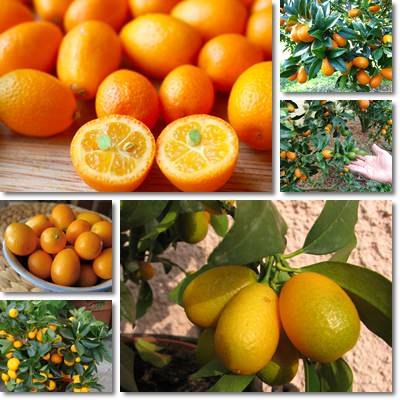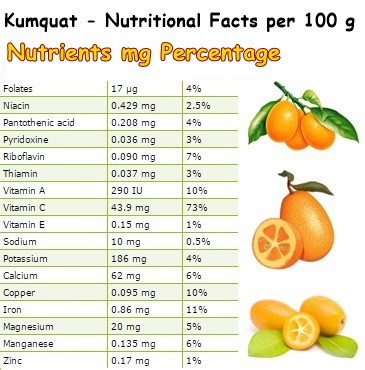A miniature orange, the kumquat (Citrus japonica) is a citrus fruit of Asian descent. Unlike many of their kind, both the tree and its fruit are frost-resistant, thus adding to the appeal for passionate gardeners. Kumquats are a rich source of vitamin C, a potent natural antioxidant and anti-inflammatory agent with excellent antiviral and antibacterial properties.
In addition to this, they contain small amounts of most essential nutrients, a quality which greatly recommends the fruit for consumption.
What is kumquat?
As mentioned above, kumquat (alternative spelling, cumquat) is a citrus tree native to the Asian continent and the islands found in the tropical Pacific Ocean. The tree can reach a maximum height of about 4-4.5 meters and is greatly resistant to frost, which is why it has been successfully introduced to temperate regions of the world from Europe and North America. Most varieties have thorny branches.
Each little kumquat tree provides a spectacular view when bearing fruit, leaving one to stare amazed at the plentifulness of its tiny branches.

What does kumquat look like?
The kumquat looks like the tiny version of an orange, or a small citrus fruit. Unimpressive, right? Unripe fruit are green. Ripe kumquats can be round, slightly oval, even somewhat pear-shaped and about the size of a not-so-big plum. They have a distinctive bright yellow-orange rind, the trademark white pith and a just as brightly colored flesh. There is also a variegated variety of kumquat with yellow and green stripes.
Types of kumquat fruit
Below is a list of the main kumquat varieties and a short description of what they look like:
- Oval kumquat (Citrus margarita), also known as Nagami. The rind, pith and flesh of this variety can all be eaten raw and together produce a savory contrast of taste.
- Round kumquat (Citrus japonica or Fortunella japonica), also known as Morgani. The rind turns golden when ripe and the fruit can be eaten raw.
- Jiangsu kumquat (Citrus obovata), also known as Fukushu. It has either a round or pear shape and turns bright orange when ripe. Unlike the other varieties, it is not frost resistant.
- Variegated kumquat looks like a miniature watermelon with pale yellow and green stripes.
What does kumquat taste like?
Kumquats generally have a sour flesh and somewhat sweet peel or rind. When eaten whole they produce an interesting flavor. Raw fruit have around 70 kcal/100 g. Kumquats can be eaten either raw or cooked. Preferred recipes include jams, jellies, marmalade. You can add them to salads, make them into salad dressings, add the juice, flesh and peel to breads, cakes, cookies and so on.

What are the benefits of Kumquat?
What is kumquat good for? Find out the top 6 health benefits of eating kumquat:
Antioxidant benefits
Kumquat offers antioxidant protection and reduces risks of chronic disease. Kumquats are a great source of antioxidants, notably vitamin C and tannins. 100 g of kumquat provides about 73% of the RDA of vitamin C, probably the most potent antioxidant which protects against oxidative stress and related health problems. Vitamin C helps counteract cell and DNA damage caused by free radicals and thus contributes immensely to the prevention of chronic diseases such as cardiovascular disease and cancer. The higher your intake of vitamin C, the healthier you are.
Anti-inflammatory benefits
Again, antioxidants and nutrients such as vitamins A, C, B vitamins, etc. help reduce inflammation levels in the body. Recent research has revealed that high inflammation levels are the starting point for chronic disease which is why it is pivotal to include anti-inflammatory foods such as green leafy vegetables, berries and cherries into our diets.
Boasts antiviral and antibacterial properties
Thanks to their high vitamin C content, kumquats boast significant antiviral and antibacterial properties, supporting the immune system in the fight against colds, flu and other viral or bacterial infections. The secret to a strong immune system is to enrich your diet with vitamin C-rich foods.

Promotes collagen production
Another wonderful health benefits of vitamin C-rich kumquats is their ability to stimulate collagen production. What is collagen? In simple words, collagen is a protein that ensures our skin, blood vessels and whole body maintains its structures. People lacking a generous intake of vitamin C will, for example, age faster and exhibit premature wrinkles.
Rich source of lutein and limonene
Lutein is a carotene and antioxidant found in kumquats, responsible for the fruit’s yellow-orange color. Lutein is essential for retina health and good eyesight and deficiencies will, in time, lead to increase macular degeneration and cataract risks.
Limonene is one of many essential oils found in kumquat (rind), making up for over 90% of the fruit’s volatile oil profile. While excessive amounts should be avoided, taking limonene from dietary sources like fruits such as kumquat, lemons or oranges has been shown to help inhibit the growth of new blood vessels that may feed tumors.
Excellent laxative properties
Kumquats provide 6.5 g of dietary fiber/100 g of fruit. Dietary fiber adds bulk to stools, easing their passing and relieving constipation which also contributes to the health of the colon. Moreover, by promoting natural fermentation processes within the digestive tract, fiber ensures digestive health.
Having an above average fiber content, kumquats make pretty great natural laxatives. They actually contain a special type of dietary fiber called pectin, which is what is responsible for the laxative effect of the fruit. Pectin is also what makes fruits bind well when turned into jams and jellies.
Conclusion
Overall, kumquats are nutritious fruit with several great health benefits. If you are fond of gardening or wish to embellish either your front porch of back garden with a delicious, frost-resistant small tree, then kumquat is your go-to. With it you will have a gorgeous ornamental plant to show off as well as a plentiful crop of healthy and lovely fruit.
